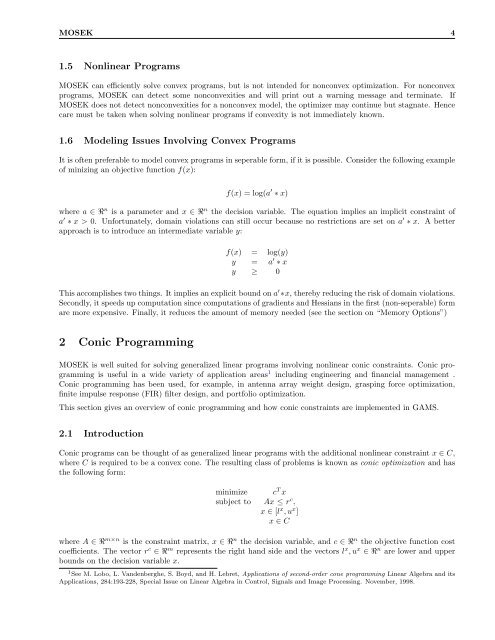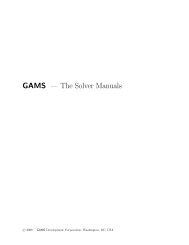Create successful ePaper yourself
Turn your PDF publications into a flip-book with our unique Google optimized e-Paper software.
MOSEK 41.5 Nonlinear ProgramsMOSEK can efficiently solve convex programs, but is not intended for nonconvex optimization. For nonconvexprograms, MOSEK can detect some nonconvexities and will print out a warning message and terminate. IfMOSEK does not detect nonconvexities for a nonconvex model, the optimizer may continue but stagnate. Hencecare must be taken when solving nonlinear programs if convexity is not immediately known.1.6 Modeling Issues Involving Convex ProgramsIt is often preferable to model convex programs in seperable form, if it is possible. Consider the following exampleof minizing an objective function f(x):f(x) = log(a ′ ∗ x)where a ∈ R n is a parameter and x ∈ R n the decision variable. The equation implies an implicit constraint ofa ′ ∗ x > 0. Unfortunately, domain violations can still occur because no restrictions are set on a ′ ∗ x. A betterapproach is to introduce an intermediate variable y:f(x) = log(y)y = a ′ ∗ xy ≥ 0This accomplishes two things. It implies an explicit bound on a ′ ∗x, thereby reducing the risk of domain violations.Secondly, it speeds up computation since computations of gradients and Hessians in the first (non-seperable) formare more expensive. Finally, it reduces the amount of memory needed (see the section on “Memory Options”)2 Conic ProgrammingMOSEK is well suited for solving generalized linear programs involving nonlinear conic constraints. Conic programmingis useful in a wide variety of application areas 1 including engineering and financial management .Conic programming has been used, for example, in antenna array weight design, grasping force optimization,finite impulse response (FIR) filter design, and portfolio optimization.This section gives an overview of conic programming and how conic constraints are implemented in GAMS.2.1 IntroductionConic programs can be thought of as generalized linear programs with the additional nonlinear constraint x ∈ C,where C is required to be a convex cone. The resulting class of problems is known as conic optimization and hasthe following form:minimize c T xsubject to Ax ≤ r c ,x ∈ [l x , u x ]x ∈ Cwhere A ∈ R m×n is the constraint matrix, x ∈ R n the decision variable, and c ∈ R n the objective function costcoefficients. The vector r c ∈ R m represents the right hand side and the vectors l x , u x ∈ R n are lower and upperbounds on the decision variable x.1 See M. Lobo, L. Vandenberghe, S. Boyd, and H. Lebret, Applications of second-order cone programming Linear Algebra and itsApplications, 284:193-228, Special Issue on Linear Algebra in Control, Signals and Image Processing. November, 1998.
















